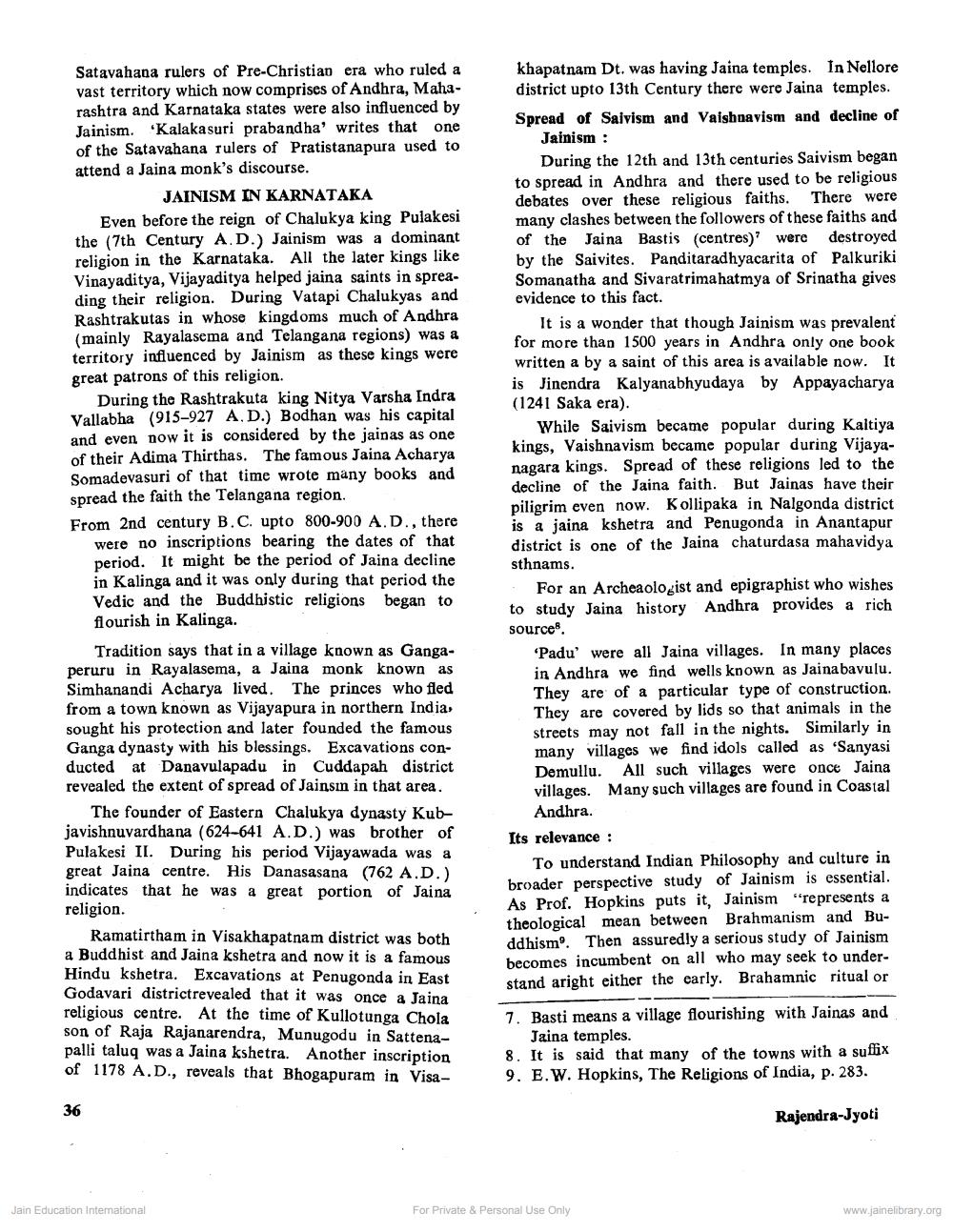________________
Satavahana rulers of Pre-Christian era who ruled a vast territory which now comprises of Andhra, Maharashtra and Karnataka states were also influenced by Jainism. "Kalakasuri prabandha' writes that one of the Satavahana rulers of Pratistanapura used to attend a Jaina monk's discourse.
JAINISM IN KARNATAKA Even before the reign of Chalukya king Pulakesi the (7th Century A.D.) Jainism was a dominant religion in the Karnataka. All the later kings like Vinayaditya, Vijayaditya helped jaina saints in spreading their religion. During Vatapi Chalukyas and Rashtrakutas in whose kingdoms much of Andhra (mainly Rayalasema and Telangana regions) was a territory influenced by Jainism as these kings were great patrons of this religion.
During the Rashtrakuta king Nitya Varsha Indra Vallabha (915-927 A.D.) Bodhan was his capital and even now it is considered by the jainas as one of their Adima Thirthas. The famous Jaina Acharya Somadevasuri of that time wrote many books and spread the faith the Telangana region. From 2nd century B.C. upto 800-900 A.D., there
were no inscriptions bearing the dates of that period. It might be the period of Jaina decline in Kalinga and it was only during that period the Vedic and the Buddhistic religions began to flourish in Kalinga.
Tradition says that in a village known as Gangaperuru in Rayalasema, a Jaina monk known as Simhanandi Acharya lived. The princes who fled from a town known as Vijayapura in northern India, sought his protection and later founded the famous Ganga dynasty with his blessings. Excavations conducted at Danavulapadu in Cuddapah district revealed the extent of spread of Jainsin in that area.
The founder of Eastern Chalukya dynasty Kubjavishnuvardhana (624-641 A.D.) was brother of Pulakesi II. During his period Vijayawada was a great Jaina centre. His Danasasana (762 A.D.) indicates that he was a great portion of Jaina religion.
khapatnam Dt. was having Jaina temples. In Nellore district upto 13th Century there were Jaina temples. Spread of Saivism and Vaishnavism and decline of
Jainism :
During the 12th and 13th centuries Saivism began to spread in Andhra and there used to be religious debates over these religious faiths. There were many clashes between the followers of these faiths and of the Jaina Bastis (centres)' were destroyed by the Saivites. Panditaradhyacarita of Palkuriki Somanatha and Sivaratrimahatmya of Srinatha gives evidence to this fact.
It is a wonder that though Jainism was prevalent for more than 1500 years in Andhra only one book written a by a saint of this area is available now. It is Jinendra Kalyanabhyudaya by Appayacharya (1241 Saka era).
While Saivism became popular during Kaltiya kings, Vaishnavism became popular during Vijayanagara kings. Spread of these religions led to the decline of the Jaina faith. But Jainas have their piligrim even now. Kollipaka in Nalgonda district is a jaina kshetra and Penugonda in Anantapur district is one of the Jaina chaturdasa mahavidya sthnams.
For an Archeaologist and epigraphist who wishes to study Jaina history Andhra provides a rich sources
*Padu' were all Jaina villages. In many places in Andhra we find wells known as Jainabavulu. They are of a particular type of construction. They are covered by lids so that animals in the streets may not fall in the nights. Similarly in many villages we find idols called as 'Sanyasi Demullu. All such villages were once Jaina villages. Many such villages are found in Coastal
Andhra. Its relevance :
To understand Indian Philosophy and culture in broader perspective study of Jainism is essential. As Prof. Hopkins puts it, Jainism "represents a theological mean between Brahmanism and Buddhism. Then assuredly a serious study of Jainism becomes incumbent on all who may seek to understand aright either the early. Brahamnic ritual or
Ramatirtham in Visakhapatnam district was both a Buddhist and Jaina kshetra and now it is a famous Hindu kshetra. Excavations at Penugonda in East Godavari district revealed that it was once a Jaina religious centre. At the time of Kullotunga Chola son of Raja Rajanarendra, Munugodu in Sattenapalli taluq was a Jaina kshetra. Another inscription of 1178 A.D., reveals that Bhogapuram in Visa
7. Basti means a village flourishing with Jainas and
Jaina temples. 8. It is said that many of the towns with a suflix 9. E.W. Hopkins, The Religions of India, p. 283.
36
Rajendra-Jyoti
Jain Education Intemational
For Private & Personal Use Only
www.jainelibrary.org




